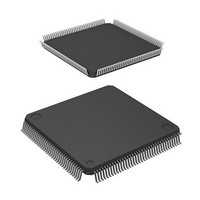D12674RVFQ33D Renesas Electronics America, D12674RVFQ33D Datasheet - Page 209

D12674RVFQ33D
Manufacturer Part Number
D12674RVFQ33D
Description
MCU 3V 0K I-TEMP 144-QFP
Manufacturer
Renesas Electronics America
Series
H8® H8S/2600r
Datasheet
1.D12674RVFQ33V.pdf
(981 pages)
Specifications of D12674RVFQ33D
Core Processor
H8S/2600
Core Size
16-Bit
Speed
33MHz
Connectivity
IrDA, SCI
Peripherals
DMA, POR, PWM, WDT
Number Of I /o
103
Program Memory Type
ROMless
Ram Size
32K x 8
Voltage - Supply (vcc/vdd)
3 V ~ 3.6 V
Data Converters
A/D 12x10b; D/A 4x8b
Oscillator Type
Internal
Operating Temperature
-40°C ~ 85°C
Package / Case
144-LQFP
Lead Free Status / RoHS Status
Contains lead / RoHS non-compliant
Eeprom Size
-
Program Memory Size
-
Other names
HD6412674RVFQ33D
HD6412674RVFQ33D
HD6412674RVFQ33D
Available stocks
Company
Part Number
Manufacturer
Quantity
Price
Company:
Part Number:
D12674RVFQ33DV
Manufacturer:
Renesas Electronics America
Quantity:
10 000
- Current page: 209 of 981
- Download datasheet (6Mb)
Section 6 Bus Controller (BSC)
If areas 2 to 5 are designated as continuous synchronous DRAM space, large-capacity (e.g. 64-
Mbit) synchronous DRAM can be connected. In this case, the CS2, CS3, CS4, and CS5 pins are
used as the RAS, CAS, WE, and CLK signals for the continuous synchronous DRAM space. The
OE pin is used as the CKE signal.
Area 6: In externally expanded mode, all of area 6 is external space.
When area 6 external space is accessed, the CS6 signal can be output.
Only the basic bus interface can be used for area 6.
Area 7: Area 7 includes the on-chip RAM and internal/O registers. In externally expanded mode,
the space excluding the on-chip RAM and internal I/O registers is external address space. The on-
chip RAM is enabled when the RAME bit is set to 1 in the system control register (SYSCR); when
the RAME bit is cleared to 0, the on-chip RAM is disabled and the corresponding addresses are in
external address space.
When area 7 external address space is accessed, the CS7 signal can be output.
Only the basic bus interface can be used for the area 7 memory interface.
6.4.4
Chip Select Signals
This LSI can output chip select signals (CS0 to CS7) for areas 0 to 7. The signal outputs low when
the corresponding external space area is accessed. Figure 6.7 shows an example of CS0 to CS7
signals output timing.
Enabling or disabling of CS0 to CS7 signals output is set by the data direction register (DDR) bit
for the port corresponding to the CS0 to CS7 pins.
In expanded mode with on-chip ROM disabled, the CS0 pin is placed in the output state after a
reset. Pins CS1 to CS7 are placed in the input state after a reset and so the corresponding DDR bits
should be set to 1 when outputting signals CS1 to CS7.
In expanded mode with on-chip ROM enabled, pins CS0 to CS7 are all placed in the input state
after a reset and so the corresponding DDR bits should be set to 1 when outputting signals CS0 to
CS7.
When areas 2 to 5 are designated as DRAM space, outputs CS2 to CS5 are used as RAS signals.
When areas 2 to 5 are designated as continuous synchronous DRAM space in the H8S/2678R
Group, outputs CS2 to CS5 are used as RAS, CAS, WE, and CLK signals.
Rev. 3.00 Mar 17, 2006 page 157 of 926
REJ09B0283-0300
Related parts for D12674RVFQ33D
Image
Part Number
Description
Manufacturer
Datasheet
Request
R

Part Number:
Description:
CCD Vertical Clock Driver
Manufacturer:
Sony Corporation
Datasheet:

Part Number:
Description:
KIT STARTER FOR M16C/29
Manufacturer:
Renesas Electronics America
Datasheet:

Part Number:
Description:
KIT STARTER FOR R8C/2D
Manufacturer:
Renesas Electronics America
Datasheet:

Part Number:
Description:
R0K33062P STARTER KIT
Manufacturer:
Renesas Electronics America
Datasheet:

Part Number:
Description:
KIT STARTER FOR R8C/23 E8A
Manufacturer:
Renesas Electronics America
Datasheet:

Part Number:
Description:
KIT STARTER FOR R8C/25
Manufacturer:
Renesas Electronics America
Datasheet:

Part Number:
Description:
KIT STARTER H8S2456 SHARPE DSPLY
Manufacturer:
Renesas Electronics America
Datasheet:

Part Number:
Description:
KIT STARTER FOR R8C38C
Manufacturer:
Renesas Electronics America
Datasheet:

Part Number:
Description:
KIT STARTER FOR R8C35C
Manufacturer:
Renesas Electronics America
Datasheet:

Part Number:
Description:
KIT STARTER FOR R8CL3AC+LCD APPS
Manufacturer:
Renesas Electronics America
Datasheet:

Part Number:
Description:
KIT STARTER FOR RX610
Manufacturer:
Renesas Electronics America
Datasheet:

Part Number:
Description:
KIT STARTER FOR R32C/118
Manufacturer:
Renesas Electronics America
Datasheet:

Part Number:
Description:
KIT DEV RSK-R8C/26-29
Manufacturer:
Renesas Electronics America
Datasheet:

Part Number:
Description:
KIT STARTER FOR SH7124
Manufacturer:
Renesas Electronics America
Datasheet:

Part Number:
Description:
KIT STARTER FOR H8SX/1622
Manufacturer:
Renesas Electronics America
Datasheet:











